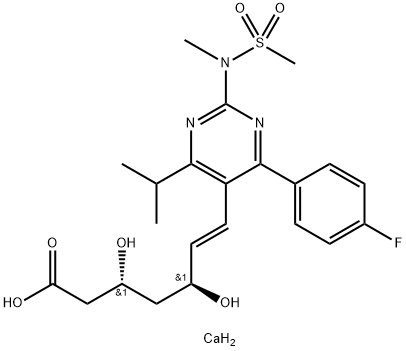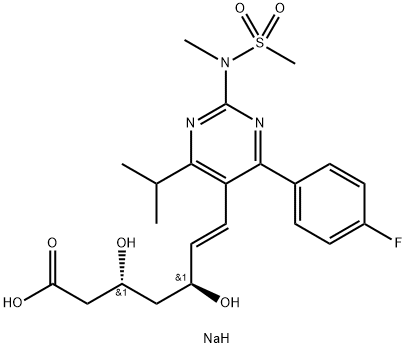Rosuvastatin Calcium , ≥99% , 147098-20-2
Synonym(s):
(E)-7-[4-(4-Fluorophenyl)-6-isopropyl-2-[methyl(methylsulfonyl)amino]pyrim idin-5-yl]-(3R,5S)-3,5-dihydroxyhept-6-enoic acid, calcium salt (2:1);Rosuvastatin calcium salt;Rosuvastatin hemicalcium
CAS NO.:147098-20-2
Empirical Formula: C22H30CaFN3O6S
Molecular Weight: 523.63
MDL number: MFCD04112702
EINECS: 627-028-1
| Pack Size | Price | Stock | Quantity |
| 200mg | RMB55.20 | In Stock |
|
| 1g | RMB97.60 | In Stock |
|
| 25MG | RMB159.20 | In Stock |
|
| 5g | RMB342.40 | In Stock |
|
| 100MG | RMB364.00 | In Stock |
|
| 25g | RMB1199.20 | In Stock |
|
| others | Enquire |
PRODUCT Properties
| Melting point: | 122°C |
| alpha | D24 +14.8° (c = 1.012 in 50% methanol) |
| storage temp. | 2-8°C |
| solubility | DMSO : 25 mg/mL (49.94 mM; Need ultrasonic)H2O : 1 mg/mL (2.00 mM; Need ultrasonic) |
| form | powder |
| color | white to beige |
| optical activity | [α]/D +12 to +18°, c = 1 in methanol: water (1:1) |
| λmax | 243nm(Phosphate buffer sol.)(lit.) |
| Merck | 14,8270 |
| InChIKey | JSVIQRTVYKCCOM-LMRKSJJTNA-N |
| SMILES | C(/C1=C(N=C(N(C)S(=O)(=O)C)N=C1C1C=CC(F)=CC=1)C(C)C)=C\[C@@H](O)C[C@@H](O)CC(=O)O.[Ca] |&1:24,27,r| |
| CAS DataBase Reference | 147098-20-2(CAS DataBase Reference) |
Description and Uses
Rosuvastatin, one of the two new statins launched for the treatment of hypercholesterolemia, has high hepato-selectivity and more potent inhibitory effect on HMG-CoA reductase than the previously marketed statins. In rat hepatocytes, it inhibits cholesterol biosynthesis with an IC50 of 1.12 nM, which is ~100-fold higher potency than pravastatin. Rosuvastatin is synthesized in a 12-step sequence, entailing the construction of a pyrimidinyl aldehyde intermediate in eight steps and subsequent introduction of the dihydroxyheptenoate side chain via Wittig reaction with a bketophosphorane reagent and stereoselective carbonyl reduction of the resultant enone. Pharmacokinetic properties of rosuvastatin in humans, dosed at 5–80 mg, are approximately linear with dose. Following oral administration, rosuvastatin is rapidly absorbed with an oral bioavailability of ~20% and tmax of ~3 h. It has a prolonged duration of action, with terminal t1/2 of ~20 h, compatible with once-daily dosing. In humans, rosuvastatin is minimally metabolized through CYP2C9 and CYP2C19, with little or no metabolism via the CYP3A4. Approximately 90% of the administered oral dose is eliminated in the feces (92% as the parent compound) and the rest in the urine. Rosuvastatin is considered a “superstatin” due to its ability, at well-tolerated doses, to lower LDL cholesterol and triglycerides to a much greater extent than first generation statins. In patients with hypercholesterolemia, rosuvastatin treatment at doses of 5 and 10 mg/day over 12-week period resulted in 40–43% reduction of LDL-cholesterol levels, 12–13% increase in HDL-cholesterol, and 17– 19% reduction in triglycerides. In comparison, the efficacy range of LDL-cholesterol reductions by atorvastatin (10 mg/day), pravastatin (20 mg/day), and simvastatin (20 mg/day) was 28–35%. Rosuvastatin is a well-tolerated drug at doses of 1–20 mg and the most common side effects at these doses are headache, myalgia, pain and pharyngitis, which are consistent with those previously reported for statin therapy.
Rosuvastatin Calcium Salt is a selective, competitive HMG-CoA reductase inhibitor. Antilipemic.
Safety
| Symbol(GHS) |  GHS07 |
| Signal word | Warning |
| Hazard statements | H302-H315-H319 |
| Precautionary statements | P261-P305+P351+P338 |
| RTECS | MJ9675070 |
| HS Code | 29350090 |


![(3R,5S)-5-((R)-8-fluoro-4-isopropyl-2-(N-methylmethylsulfonamido)-5,6-hydrobenzo[h]quinazolin-6-yl)-3,5-dihydroxypentanoate calcium(II)](https://img.chemicalbook.com/StructureFile/ChemBookStructure21/GIF/CB2489683.gif)

![Methyl 4-(4-fluorophenyl)-6-isopropyl-2-[(N-methyl-N-methylsulfonyl)amino]pyrimidine-5-carboxylate](https://img.chemicalbook.com/CAS/GIF/289042-11-1.gif)
![4-(4-Fluorophenyl)-6-isopropyl-2-[(N-methyl-N-methylsufonyl)amino]pyrimidine-5-yl-methanol](https://img.chemicalbook.com/CAS/GIF/147118-36-3.gif)
